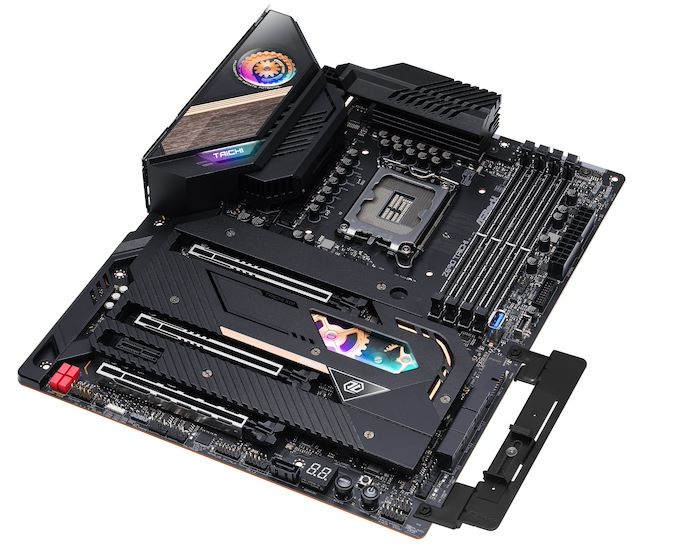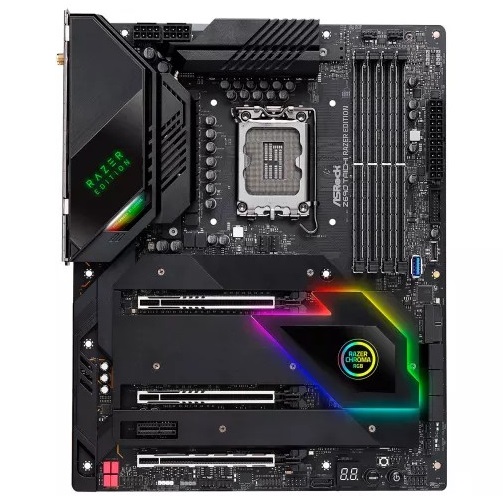The Intel Z690 Motherboard Overview (DDR5): Over 50+ New Models
by Gavin Bonshor on November 9, 2021 9:00 AM ESTASRock Z690 Taichi & Z690 Taichi Razer Edition
Kicking off our Z690 overview in alphabetical order, we'll start with ASRock. ASRock includes its patent-pending ASRock Graphics Card Holder with all of its Z690 models. This is designed to help prevent sagging when used with heavier and long graphics cards.
As it currently stands, the most premium model in ASRock's arsenal for Z690 is from one of its most successful motherboards series, the Taichi. The ASRock Z690 Taichi has a variety of premium features including an advertised 20-phase power delivery with the latest 105 A power stages, as well as a slightly redefined look for 2021. Touching on the design, ASRock includes its mechanical cogwheel effect built into the rear panel cover, which includes RGB LED backlighting, with more RGB built into the cleverly designed cogwheel inspired chipset heatsink.
Looking at the lower portion of the Z690 Taichi, it includes three full-length PCIe slots, including the top two operating at PCIe 5.0 x16 and x8/x8, a third full-length PCIe 4.0 x4 slot, and one PCIe 3.0 x1 slot. Focusing on storage, the ASRock Z690 Taichi includes two PCIe 4.0 x4 M.2 slots, with a third M.2 slot that has support for both PCIe 3.0 x4 and SATA drives. The board also features seven SATA ports in total, with six of these supporting Intel RAID 0, 1, 5, and 10 arrays. Located in the top right-hand corner are four memory slots that can support DDR5-6400, with a combined capacity of up to 128 GB.
The ASRock Z690 Taichi Razer Edition shares the same feature set as the regular Z690 Taichi, but with a Razer-inspired twist. This includes a funky Razer Edition logo on the rear panel cover, with Razer Chroma RGB LED lighting which from the image above, pops really nicely. It drops the cogwheel theme of the Taichi and essentially replaces it with Razer branding.
On the rear panel of the ASRock Z690 Taichi is a pair of Thunderbolt 4 Type-C ports, with two USB 3.2 G2 Type-A, and four USB 3.2 G1 Type-A ports. Onboard audio is handled by a Realtek ALC1220 HD audio codec and ESS Sabre 9218 DAC pairing and consists of five 3.5 mm audio jacks and one S/PDIF optical output. Interestingly, ASRock has put the audio connectors in the middle of the rear panel, as opposed to the end. For networking, ASRock is using a Killer E3100G 2.5 GbE controller, with an additional Intel I219-V Gigabit controller, with a Killer AX1675 Wi-Fi 6E CNVi. Finishing off the rear panel is a single HDMI 2.1 video output and a small BIOS Flashback button.













126 Comments
View All Comments
DanNeely - Tuesday, November 9, 2021 - link
Good point. I thought Intel was pushing hard for 12vo with the 6xx series, but it seems to be completely MIA.Silver5urfer - Tuesday, November 9, 2021 - link
Can I ask why ? What does ATX12VO provide to a consumer ?It doesn't make your mobo cheap, it doesn't make your mobo less complicated, it does not make your system run cooler, it doesn't make ADL consume less power, It doesn't even make any sense.
ATX12VO was created because of that trash policies set by policing state of California about some nonsensical rubbish. Servers and Data centers can get away with modular high density PSUs because of fully standardized set and they also get 3M liquid cooling. This is consumer market and here we have people wishing for backwards in technology.
meacupla - Thursday, November 11, 2021 - link
A lot of people had the same sentiment about EU RoHS restrictions, and yet, it was implemented worldwide.With that attitude, the same can be said about energy star, and 80plus certifications. It adds cost to the product, yet it offers not a thing to the consumer.
Not everything is about you.
We need to do everything we can to cut down power consumption, and ATX12VO standardization across the entire industry is very low hanging fruit.
Stop being so selfish, there's literally only one habitable planet we have right now.
Oxford Guy - Thursday, November 11, 2021 - link
80 Plus offered plenty to consumers. Less power use means quieter PSUs.The knock on 80 Plus was unrealistically easy testing. Despite that, it helped raise the efficiency of PSUs. Along with better efficiency, ripple, holdout time, voltage consistency, and other factors improved — as enthusiasts began to pay more attention to PSU quality.
I don’t doubt that 80 Plus also helped a lot of non-enthusiasts/amateurs by keeping them away from ultra-cheap PSUs that catch fire. Having a high-profile certification that those PSUs can’t reach helped to steer those customers away.
yacoub35 - Tuesday, November 9, 2021 - link
That white metal trim running tight around the molex power connector on the ASUS ROG Maximus Z690 Formula must make it an absolutely nightmare to plug/unplug the main power cable to the board.Ranguvar - Tuesday, November 9, 2021 - link
Correction:"Previously with 11th gen (Rocket Lake), Intel upheaved it from a PCIe 3.0 x4 uplink on Z490 to a PCIe 3.0 x4 uplink on Z590."
This should say "to a PCIe 3.0 x8 uplink on Z590".
OFelix - Tuesday, November 9, 2021 - link
Correct. And whilst we are correcting that sentence - "upheaved" ????This first page really needs to be read by an AnandTech editor.
What's that? They don't any editors? :-(
OFelix - Tuesday, November 9, 2021 - link
"Z490 Motherboard Audio" ... presumably Z690?mode_13h - Friday, November 12, 2021 - link
I caught that, as well. Even the word "upheaved" is itself somewhat noteworthy. Plenty of better alternatives: "upgraded", "widened", "expanded", "increased", "enlarged", etc.GeoffreyA - Saturday, November 13, 2021 - link
While "upheaved" is likely an error, it's not far off from the words of today. Unfortunately, the English language is on a downgrade, and it's just going to get worse and worse. The language's genius is not tuned to the over-economical forms we're finding today; and a lot of it seems to be coming from tech. Upthis, upthat. My favourite, though, is leverage. A big, scary word that companies are fond of, and which escaped its programming, game development roots. Soon, we'll be leveraging the kettle to make tea. How about using?